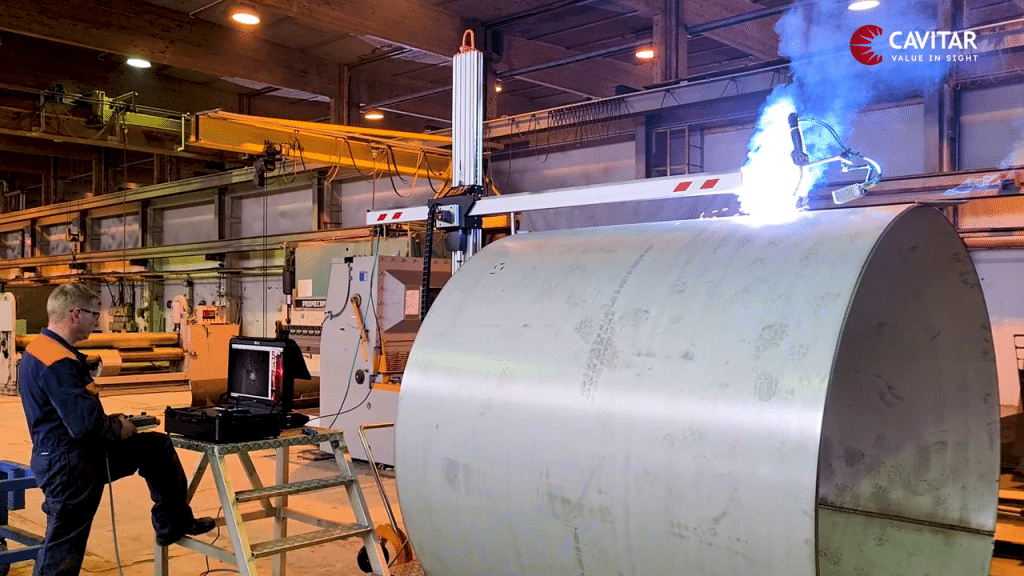Sponsored by CavitarReviewed by Louis CastelDec 19 2024
Speed is important in industrial processes. The faster a process can occur, the more efficient the production line or manufacturing process will be. However, increased speed can result in unique challenges, particularly when comprehending, monitoring, and troubleshooting rapid phenomena.
High-speed imaging illumination offers a lens that enables viewing intensely bright exothermic processes and accurate imaging of shockwaves, flows, and various physical events that occur in manufacturing. This means that high-speed imaging illumination can revolutionize how we see and analyze industrial operations, resulting in a method for improving processes.1

Image Credit: Cavitar
Clear Visibility: A New Perspective on Fast-Moving Objects
By capturing multiple frames in fast succession, high-speed imaging basically “freezes” motion, allowing for a detailed and unobstructed view of an object’s behavior and trajectory.
Appropriate illumination improves this process by providing the required light intensity and direction to illuminate the object precisely at each captured frame. This ensures that even in environments where traditional imaging methods would create blurry or indistinct results, high-speed imaging with the correct amount of illumination delivers clear, detailed, and actionable visual data.1
Stress-strain test of brittle material with Hopkinson Bar
Video Credit: Cavitar
The enhanced visibility offered by high-speed imaging illumination enables engineers, researchers, and technicians to analyze and discern intricate dynamics and characteristics of rapidly moving objects with unparalleled accuracy. This method can identify potential defects or inefficiencies in a process, which helps to lay the groundwork for targeted troubleshooting. The result can include risk mitigation, quality enhancement, improved operational efficiency, and informed decision-making.
Improved Image Quality: The Role of CAVILUX Laser Illumination
High-Speed MIG Welding 20,000 fps - CAVILUX Laser Illumination
Video Credit: Cavitar
Laser illumination, and in particular CAVILUX laser systems, plays a fundamental role in enhancing the image quality of high-speed imaging systems. Using high-power, ultra-short laser pulses eliminates motion blur, leading to crisp and clear images. Using monochromatic and low-coherence light further ensures optimal image quality without chromatic aberrations or speckle.
This means improved image analysis and interpretation, which offers a clearer look into phenomena understanding, a reduction in the ambiguity of processes, and improved results in comparison studies.2
Freezing Motion: How to Capture the Unseen
When there is no additional light, the images gained from ultra-high frame rates (MHz range) are dark and show motion blur.
The resulting images are very bright and crisp when the scene is illuminated with ultra-short laser pulses during each frame. Phenomena that would have been blurred can be captured in impressive detail through high-speed imaging illumination.2 This is a game-changer, particularly in industries where even the smallest details matter, like aerospace or additive manufacturing.
Temporal analysis of quick processes can reveal hidden dynamics, validate theoretical models through real-world data, and allow for motion trajectory mapping. The latter analysis is crucial in understanding spattering paths, accelerations, and velocities essential for process optimization in additive manufacturing.3
Real-Time Visual Monitoring and Analysis: Illuminating the Benefits
When special visualization techniques are unavailable, the light created by welding has too much intensity to be monitored by standard camera systems. Cavitar’s Welding Cameras, such as the C300 and C400, allow engineers to monitor welding processes in real-time with unmatched clarity. With the ability to capture up to 500 frames per second, these plug-and-play cameras can assist with visualizing the behavior of the melt pool and filler material.
CMT Captured at 500fps with Cavitar Welding Camera
Video Credit: Cavitar
Cavitar C300 & C400 Welding Cameras utilize built-in laser illumination and customized filtering optics. This technology is unique and allows for real-time monitoring of welding processes. Early error detection means higher quality output, reduced scrap, and significant financial savings.4
The ergonomic benefits of these systems cannot be ignored. Welders face common risks, including repetitive injury and poor posture, which can result in musculoskeletal injuries, a reduction in work quality, and productivity losses.4,5 Cavitar systems can be operated from a safe distance, and welders can benefit from better working ergonomics.4
A Bright Future for Industrial Processes
Combining high-speed imaging and illumination lasers has led to a new era in industrial processes. Clear visibility rendered through “freezing” motion, better image quality, and real-time monitoring are just a sampling of the incredible advancements transforming industries. Cavitar is a pioneer in this area, offering a range of illumination systems and welding cameras that are redefining how industrial operations are perceived and interacted with.
Comparison video: Shockwave formation in gel - CAVILUX Illumination - Cavitar Ltd.
Video Credit: Cavitar
Cavitar provides “Value in Sight” with cutting-edge illumination systems and welding cameras. These versatile products are designed for various applications, from industrial visual process monitoring to scientific research. Those in R&D, OEM manufacturers, and end-users will find solutions tailored to their unique needs.
References and Further Reading
- Cavitar Ltd. Laser light for high-speed imaging, CAVILUX HF. Available at: https://www.cavitar.com/wp-content/uploads/2018/10/Cavilux_HF_esite_26102018_web.pdf.
- Cavitar WELCOME TO THE INVISIBLE WORLD. Available at: https://www.cavitar.com/wp-content/uploads/2022/10/Cavilux-Schlieren-OEM_Cavitar_WEB.pdf.
- Yin, J. et al. (2019). Correlation between forming quality and spatter dynamics in laser powder bed fusion, Additive Manufacturing, 31, p. 100958. https://doi.org/10.1016/j.addma.2019.100958.
- Cavitar Ltd - See What You Have Missed (2023) Welding Camera | Welding Vision System | Welding Analysis. Available at: https://www.cavitar.com/product/cavitar-welding-camera/.
- Nedohe, K., Mpofu, K. and Makinde, O. (2022). Assessment of ergonomics risk experienced by welding workers in a rail component manufacturing organization, in Lecture notes in mechanical engineering, pp. 227–236. https://doi.org/10.1007/978-3-031-18326-3_23.

This information has been sourced, reviewed and adapted from materials provided by Cavitar.
For more information on this source, please visit Cavitar.